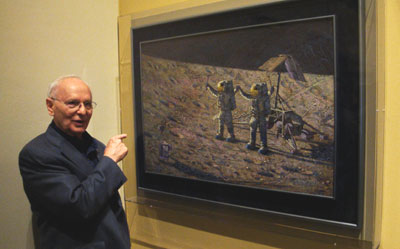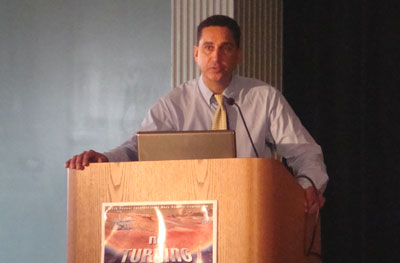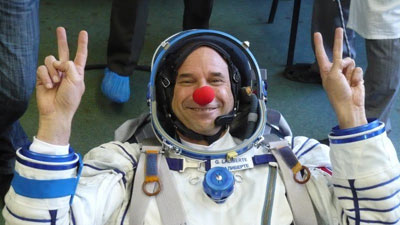When space and art intersectby Jeff Foust
|
| “When I decided to join Expedition 21, I knew there would be an artistic component to my mission,” Laliberté said. “I am an artist, not a scientist, so it was my duty to contribute in my own way.” |
Last week, in a press conference webcast that coincided with his 50th birthday, Laliberté unveiled new details about his mission to the ISS that is scheduled for launch at the end of this month. The highlight will be a unique two-hour event, “Moving Stars and Earth for Water”, scheduled for October 9 in 14 cities around the world, as well as the space station. Events in those cities will feature a diverse range of artists and other celebrities, from U2 and Peter Gabriel to former vice president Al Gore. The events will all be tied together by a “poetic tale” created for the mission by Canadian author Yann Martel, with Laliberté serving as something of a master of ceremonies, providing his perspective, as well as videos and photos, from his orbital perch.
“When I decided to join Expedition 21, I knew there would be an artistic component to my mission,” he said. “I am an artist, not a scientist, so it was my duty to contribute in my own way… My wish is to touch people through an artistic approach and if we manage to do so, we will go beyond awareness.”
That poetic aspect, Laliberté said, serves as the “bone structure” for the overall event. “I need to add a skeleton on which I could build the artistic event,” he said. “With that poem, it will clearly guide everybody and will clearly—I hope so—transmit the message” of the importance of clean water.
While Laliberté got his start with stilt-walking and fire-breathing, neither of those activities translates well to the zero-g environment of the ISS, so his activities on the station will be more, well, down to Earth. “The main task that I have to do is taking pictures, engaging in dialogue through links to Earth, and prepare beforehand some of the work,” he said.
The flight, though, links Laliberté back to 40 years ago, when he watched the Apollo 11 landing on television. “I then realized, and started to believe, that fairy tales were possible. I built my life believing in my dream and wanting to travel. This is the extension of pursuing my life as a dreamer, but also an achiever of things. If that could inspire people to achieve their dreams, great.”
 Apollo 12 astronaut Alan Bean discusses one of his painting on exhibit at the National Air and Space Museum. (credit: J. Foust) |
The lunar artist
While Laliberté is an artist inspired to go into space, Alan Bean is an artist inspired by going into space, in particular the Moon. The former astronaut entered the history books by becoming the fourth man to walk on the Moon as the lunar module pilot on Apollo 12 in 1969, but arguably his greater claim to fame is what he’s done in the years since then, using that experience as the basis for a second career as a painter.
In July, an exhibition of his paintings opened at the National Air and Space Museum in Washington. The approximately 50 paintings there represent the largest single exhibition of his works to date, and are coupled with related artifacts, from the tools he uses to make his painting to some of the objects depicted in them.
| “I looked around the office and saw a lot of young men and women who could fly the space shuttle as good as I could or better, but I didn’t see anybody around, of the 12 of us who got the gift of walking on the Moon, who was interested in telling these stories this way.” |
Bean, speaking at a press event shortly before the exhibit opened, described how he had been painting for years as a hobby while in the astronaut corps, but had stuck to primarily “Earthly scenes” until convinced by some of his fellow astronauts to broaden his horizons. “‘Why do you keep painting the Earth? You’re the first artist in all of history to go anywhere but the Earth, but you keep painting the Earth,’” he recalled them telling him. He initially objected, citing the lack of color and action on the Moon, but eventually decided to take up the challenge.
At the time, Bean recalled, he was training to become a commander of an early shuttle mission. “I liked the job, I thought it was the best job in the world. I struggled all my previous career to get this job,” he said. “I looked around the office and saw a lot of young men and women who could fly the space shuttle as good as I could or better, but I didn’t see anybody around, of the 12 of us who got the gift of walking on the Moon, who was interested in telling these stories this way.”
With that realization, he took the leap and left NASA to become a full-time artist. That moved surprised a lot of his colleagues, who were skeptical that Bean could make a living as an artist (Bean recalled that when he broke the news to George Abbey, his boss at the time, Abbey very nearly fell backwards out of his chair.) “About half or two-thirds of them thought it was crazy,” Bean said. “They all like it now.”
The reason why they like it, he said, is that he is chronicling the adventure that was the Apollo program in his own way. And that style has evolved over time, as shown in the gallery, as he experimented with colors, added textures from a lunar spacesuit boot and tools, and even incorporated lunar dust particles that were embedded into his suit patches. Over time he’s added more color to his paintings, seeing the Moon as more than a lifeless gray landscape.
“I didn’t have the skill” to add those colors to his earlier works, he explained, “but mostly, I didn’t have the heart of an artist when I first left [the astronaut corps], I had the heart of an astronaut. And it’s taken these 28 years to gradually go from the heart of an astronaut over to the heart of an artist.”
 National Symphony Orchestry associate conductor Emil de Cou describes his efforts to marry art and space at the Mars Society Convention at the University of Maryland lasy month. (credit: J. Foust) |
Space art as inspiration
So what is the role that space art, in its many forms, plays? That was a topic addressed by a diverse panel—featuring painters, writers, and a symphony conductor, among others—at the annual Mars Society Convention last month at the University of Maryland.
“It comes in many different shapes and sizes and forms,” painter Michael Carroll, the panel moderator, said of space art. “Space art informs us and inspires us.”
It’s that latter role—inspiration—that may be critical. “I can say that I’m probably sitting here today because of space art,” said author Andrew Chaikin. “That’s what hooked me when I was five years old. The illustrations in my astronomy books when I was a kid were, as I have written, like ‘magic portals’ that transported me from my parents’ house to other worlds.”
The art from the early era of space exploration, he said, such as illustrations of the rockets and spacecraft being developed to go to the Moon, was essential to making a connection with the public. “The art was one of the things that made space exploration a cultural event. It was very much part of the way we as a culture experienced space exploration, even aside from the photographs, because it was really the art that conveyed the excitement.”
| “I can say that I’m probably sitting here today because of space art,” said author Andrew Chaikin. “That’s what hooked me when I was five years old.” |
That connection between exploration and art is lacking today, said Emil de Cou, associate conductor of the National Symphony Orchestra (NSO) in Washington. “There used to be a much closer overlap between the imaginative source of science and art that was shared in the years before that caught so much of our imagination,” he said during the panel session. “That’s why everybody is in this room today, not so much because of some hard scientific fact that you read as a child, but it was from reading Amazing Stories magazine, or watching Star Trek or Lost in Space.”
At the NSO de Cou has organized several collaborative events with NASA, including a performance in July to mark the 40th anniversary of Apollo 11. That event included a variety of music from Dvorak to John Williams, images from the Moon, and guest appearances from Buzz Aldrin and STS-125 commander Scott Altman. “It was an amazing, inspired grab bag of people and events that came together as a whole,” de Cou said, “and, I think, informed in that sense of imagination and hopefulness that we had in 1969 when people were not so embarrassed to dream in public.”
“I think we brought a little bit of that spirit of 1969 back to the Kennedy Center with this event,” he said.
That belief—of the deep emotional connection that the arts can bring—was shared last week by Laliberté. “I truly believe that through art, and artistic events, you can touch the hearts of people.”
